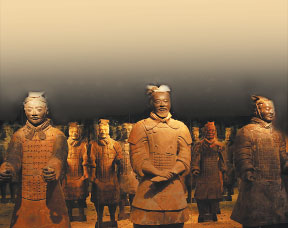
The history of ancient Rome and the Qin and Han dynasties (221 BC-AD 220) shared similarities and produced civilizations that influenced human development for centuries. An exhibition, entitled Qin-Han and Roman Civilizations, is ongoing at the Beijing World Art Museum.
As one of the opening programs to celebrate Chinese Culture Year in Italy in 2010, this exhibition displays nearly 500 cultural relics from China's Qin and Han dynasties and ancient Rome, which were gathered from more than 70 museums in China and Italy.
One of the most famous exhibits is Alexander and Roxana, a painting depicting Alexander the Great's marriage.
An elaborate oblong bronze mirror that weights 56 kg and dates from the Han Dynasty is also displayed, along with a porcelain jar made in 175 AD, one of the oldest examples of Chinese ceramic art.
China's chaotic Warring States Period (475-221 BC) came to an end in the 3rd century BC, when the Qin state conquered six rival states and put the whole of China under its rule. The Han Dynasty inherited the laws and institutional systems of its predecessor and laid the foundations for the country.
During the same period, Rome conquered the area around the Mediterranean Sea. The two ancient empires echoed each other's achievements.
Each had a far-reaching influence over Western and Eastern civilizations and political systems, architecture, and codes of conduct.
The show gives a comprehensive picture of life in that age, according to museum spokesman Fang Xiaofeng.
The exhibition is held as part of the activities to celebrate the 60th birthday of the founding of the People's Republic of China. After the Beijing debut, it will move to Luoyang city in Henan province. After its China show, the exhibition will go to Italy for two shows in Milan and Rome in 2010.
9 am-5 pm, until Oct 7. Beijing World Art Museum, China Millennium Monument, A9 Fuxinglu, Haidian district. 6851-3322
中华世纪坛世界博物馆,复兴路9号
(China Daily September 9, 2009)